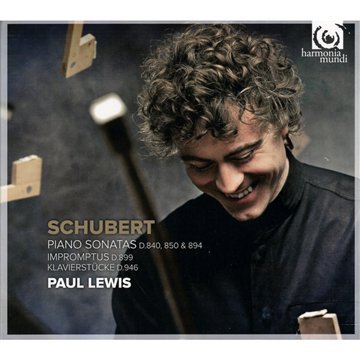SCHUBERT Piano Sonatas D850; D;840; D894
Harriet Smith is bowled over by Paul Lewis’s return to the sonatas of Schubert
View record and artist detailsRecord and Artist Details
Composer or Director: Franz Schubert
Genre:
Instrumental
Label: Harmonia Mundi
Magazine Review Date: 02/2012
Media Format: CD or Download
Media Runtime: 157
Mastering:
Stereo
DDD
Catalogue Number: HMC90 2115/16

Tracks:
| Composition | Artist Credit |
|---|---|
| Sonata for Piano No. 17 |
Franz Schubert, Composer
Franz Schubert, Composer Paul Lewis, Piano |
| Sonata for Piano No. 18 |
Franz Schubert, Composer
Franz Schubert, Composer Paul Lewis, Piano |
| Impromptus |
Franz Schubert, Composer
Franz Schubert, Composer Paul Lewis, Piano |
| Sonata for Piano No. 15, 'Relique' |
Franz Schubert, Composer
Franz Schubert, Composer Paul Lewis, Piano |
| (3) Klavierstücke |
Franz Schubert, Composer
Franz Schubert, Composer Paul Lewis, Piano |
Author: Harriet Smith
Following his Beethoven immersion on record, Paul Lewis returns to Schubert, some of whose sonatas he set down a decade or so ago for Harmonia Mundi (3/02R, 5/03), a project left tantalisingly in the air. Well, it was worth the wait: in the intervening time he has developed into arguably the finest Schubert interpreter of his generation (as anyone who has heard him live recently will know, not to mention the remarkable disc of duets released in 2010 with Steven Osborne – Hyperion, 12/10). Undoubtedly his immersion in the three song-cycles has left its mark too: the links between Schubert’s Lieder and his instrumental writing are everywhere apparent.
The Drei Klavierstücke, D946, that end the set are one of many highlights. Published posthumously some 40 years after Schubert’s death, these extraordinary works are as demanding on the performer as any of the late piano sonatas. Lewis combines a haloed sound with a sense of drama and an unerring instinct for pacing. In passages such as the C minor section of No 2, he combines the intellectual acumen of Alfred Brendel with a still more vivid palette. The shadowy opening of No 3 is a miracle of colouring combined with a sure narrative sense, as involving as if it possessed a text as the music grows in turbulence and menace.
Time and again, you marvel at the confidence and sureness of Lewis’s playing, combined with the finesse and musicality that he has always displayed. It’s the kind of playing, in fact, where comparisons cease to matter. But that would be to shirk my reviewerly duty. In the first movement of the D major Sonata, D850, Lewis really brings out the Beethovenian panache of the writing. Few drive through those opening chords with quite as much conviction: neither the less immediately recorded Richard Goode nor Mitsuko Uchida (compelling though they are), although Leif Ove Andsnes is close in this respect.
But balancing that is the sheer variety of nuance in Lewis’s quiet playing, not least in the slow movement, with its restrained rhetoric here brought out by a perfectly judged tempo. The finale has that tricky balance of sufficient momentum, humour and also a sense of wonder. Uchida is strikingly dreamy here but less unerring as a travel companion. Brendel, on the other hand, reminds us above all that wit is an essential ingredient in this movement.
Schubert of course famously struggled with the sonata, as the many torsos littered along the way attest. But, as so often, particularly when we’re talking Schubert or Bruckner, their unfinished works speak volumes more than the completed opuses of many lesser figures. In the case of the C major Sonata, D840 (dubbed ‘Reliquie’ by an early editor in the mistaken assumption that it was Schubert’s last sonata), he completed two of a projected four movements. In Lewis’s hands the symphonic range of thinking is raptly caught, as is the ambiguity and changeability of mood, together with the twisting shifts of key: how very un-C major this piece is.
The late G major Sonata, D894 (written in late 1826, only months after that other extraordinary G major work, the last string quartet) is equally impressive. Less daringly slow in the Andante than Arcadi Volodos (though the Russian, perhaps more than any other pianist of today, has the range of tone colour to back this up), Lewis is particularly impressive in the driving third movement, which contrasts so vividly with the hushed Trio section; it’s playing that is reminiscent of Sviatoslav Richter’s way with Schubert, though without his penchant for sometimes questionable tempi. And Lewis’s wispy ending of the sonata is magical.
When it comes to the first set of Impromptus, D899, you’re not going to prise Edwin Fischer’s or Krystian Zimerman’s versions out of my hand, but Lewis’s is absolutely up there with them. The G flat Impromptu is simply ravishing. Oh, and the recording itself is unobtrusively fine too. An undoubted contender for the 2012 Awards.
Discover the world's largest classical music catalogue with Presto Music.

Gramophone Digital Club
- Digital Edition
- Digital Archive
- Reviews Database
- Full website access
From £8.75 / month
Subscribe
Gramophone Full Club
- Print Edition
- Digital Edition
- Digital Archive
- Reviews Database
- Full website access
From £11.00 / month
Subscribe
If you are a library, university or other organisation that would be interested in an institutional subscription to Gramophone please click here for further information.




